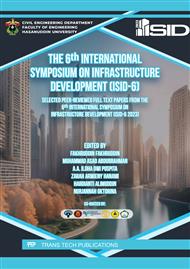[1]
L. Alberti, Evaluation of Fresh Groundwater Lens Volume and Its Possible Use in Nauru Island, Journal Water 14:3201 MDPI (2022).
DOI: 10.3390/w14203201
Google Scholar
[2]
A. Falkland, Hydrology and Water Resources of Small Island: A Practical Guide. A contribution to the International Hydrological Programme, United Nations Educational, Scientific and Cultural Organization, (1991).
Google Scholar
[3]
A. Falkland, Hydrology and Water Management in Small Tropical Island, Proceedings of an international symphosium, Yokohama, Japan, (1993).
Google Scholar
[4]
A.D. Werner, et al, Hydrogeology And Management Of Freshwater Lenses On Atoll Islands : Review Of Surrent Knowledge And Research Needs, J. of Hydrology 551 (2017) 819-44.
DOI: 10.1016/j.jhydrol.2017.02.047
Google Scholar
[5]
H. Hendrayana, Intrusi Air Asin ke Dalam Akuifer di Daratan (Jurusan Teknik Geologi. Fakultas Teknik. Universitas Gadjah Mada. Yogyakarta), (2002).
DOI: 10.29408/geodika.v4i2.2643
Google Scholar
[6]
D. Marganingrum, Y. Sudrajat, Estimasi Daya Dukung Sumber Daya Air di Pulau Kecil (Studi Kasus Pulau Pari), Jurnal Wilayah Lingkungan Vol.6 (2018) 164-182.
DOI: 10.14710/jwl.6.3.164-182
Google Scholar
[7]
R. Wang et all, Determination of Exploitable Coefficient of Coral Island Freshwater Lens Considering the Intergrated Effects of Lens Growth and Contraction, Journal Water 15:890 MDPI (2023).
DOI: 10.3390/w15050890
Google Scholar
[8]
L. Alberti, et al, Evaluation of Fresh Groundwater Lens Volume and Its Possible Use in Nauru Island, Journal Water 14:3201 : MDPI (2022).
DOI: 10.3390/w14203201
Google Scholar
[9]
Y. Tang, et al, Experimental and Modeling Investigation of Pumping From a Fresh Groundwater Lens in an Idealized Strip Island, Journal of Hydrology 602 (2021) 126734.
DOI: 10.1016/j.jhydrol.2021.126734
Google Scholar
[10]
P. Charisma, P. Subardjo, I. Pratikto, Studi Potensi Pulau Pisang Bagian Utara Untuk Perencanaan Kawasan Wisata Pantai Kabupaten Lampung Barat Provinsi Lampung, Journal Of Marine Research 2 (2013) 138-46.
Google Scholar
[11]
M. Adimas Amri, Analisis Hidrogeologi Airtanah Dangkal Dalam Menentukan Intrusi Air Laut Daerah Sunter dan Sekitarnya, Jakarta Utara, J. of Geoscience Engineering & Energy 2 (2021) 157-69.
DOI: 10.25105/jogee.v2i2.9934
Google Scholar
[12]
S. Yoshimoto, et al, Using Hydrogeochemical Indicators To Interpret Groundwater Flow And Geochemical Evolution of a Freshwater Lens on Majuro Atoll, Republic of the Marshall Islands, Hydrogeology Journal (2020) 28: 1053-1075.
DOI: 10.1007/s10040-019-02105-w
Google Scholar
[13]
K. Koda, M. Tsujimura, T. Uchida, Groundwater Flow and Water Pumping Method During Drought in Atoll Islands: Laura Island in the Republic of the Marshall Islands, Paddy and Water Environmental (2023) 21:353-363.
DOI: 10.1007/s10333-023-00933-x
Google Scholar
[14]
H. Hendrayana, D.P.E. Putra, A. Briyan and D. Joli, Kajian Intrusi Air Laut Di Wilayah Pesisir Jepara, Jawa Tengah, Kongres & Pertemuan Ilmiah Tahunan Ke-2, Yogyakarta (2017) 1-11.
Google Scholar
[15]
J. Klassen, D.M. Allen and D. Kirste, Chemical Indicators of Saltwater Influence for the Gulf Islands, British Columbia (Department of Earth Sciences. Simon Fraser University), Final Report (2014) 1-32.
Google Scholar
[16]
I. Clark, Groundwater Geochemistry and Isotopes, New York: CRC Press, (2015).
Google Scholar
[17]
E. Febriarta E, M. Widyastuti, Kajian Kualitas Air Tanah Dampak Intrusi di Sebagian Pesisir Kabupaten Tuban, J. Geo. 17 (2020) 39-48.
DOI: 10.15294/jg.v17i2.24143
Google Scholar
[18]
A. Cahyadi, T.N. Adji, M.A. Marfai, Aris M, Analisis Evolusi Hidrogeokimia Airtanah Di Pulau Koral, Kepulauan Seribu Sem Nas Geo UMS (Surakarta) (2015) 1-8.
DOI: 10.31227/osf.io/dcbup
Google Scholar
[19]
Naily W, Sudaryanto, Cl/Br Ratio to Determine Groundwater Quality, IOP Conf. Ser: Earth Environ. Sci 118 (2018).
DOI: 10.1088/1755-1315/118/1/012020
Google Scholar


